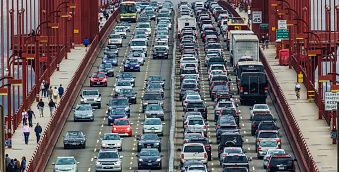As any California-phile knows, the difference between the northern and southern parts of the state are pronounced, and proudly protected by the denizens of each.
But a recent study shows that San Francisco may have more in common with its southerly neighbor Los Angeles than its residents would care to admit—and it’s not making them happy.
The City by the Bay was ranked the second worst city in America for traffic in 2016, coming in just behind L.A., in an annual poll conducted by navigation system company TomTom.
And, in the wake of the unfortunate designation, city officials were quick to name a culprit: the influx of rideshare drivers flooding San Francisco’s charming, narrow streets.
As many as 45,000 Uber and Lyft drivers now actively work in the area, a trend that has helped extend the average San Francisco commute by an extra 37 minutes per day, according to a state filing submitted by the San Francisco Municipal Transportation Agency (SFMTA).
Is Ridesharing Caring?
While not intended as a traffic study, the regulatory filing clearly calls out the rideshare companies, referred to as “transportation network companies,” or TNCs, as a large contributing factor to the congestion, stating that “[m]uch of the increase San Francisco has experienced in vehicular traffic can be attributed to the huge increase in the number of TNC vehicles operating on city streets.”
Another potential factor, unmentioned in the document, may be the 140,000 new jobs San Francisco grew by last year, but the addition of only 50,000 new residents to the city itself, leading to the creation of a larger Bay Area commuting culture.
Submitted earlier this month by the SFMTA to the California Public Utilities Commission (CPUC), the measure is an attempt to even the playing field between the ocean of Uber and Lyft employees and the city’s comparatively tiny force of 1,800 cabbies, who, unlike the rideshare drivers, must adhere to strict government protocols in order to operate. Specifically, it states that there’s little-to-no difference between renting a car to work for a ride-hailing app and driving for a typically regulated ride charter company.
The filing also pointed out the potential environmental impact of that many extra vehicles on the road, asking the CPUC to conduct a full investigation into the traffic’s affect on air quality and other ecological factors.
Crunching the Crunchy Numbers
But while the other aspects of the filing will be analyzed further in the future, it’s unclear what—if anything—CPUC will do with the traffic information, despite the fact that this is not the first time the ride-hailing giants have been accused of clogging the roadways of major urban areas.
After facing backlash in New York City last year, Uber dumped a huge spreadsheet of statistics on the public, saying that its for-hire cars’ affect on the road paled in comparison to that of the city’s famous yellow taxis.
While on the surface, the app company’s numbers looked innocuous—Uber reported only 1,904 of its cars were in the “core” of Manhattan Island during peak driving hours—some deeper analysis by traffic experts showed the rideshare giant’s workforce was still responsible for making the flow at least 8 percent slower.
Still, another study conducted by the University of Arizona found the ridesharing model was actually successful in reducing traffic in over 80 urban areas across the U.S.
Driving Forward
Of course, predicting traffic patterns is extremely difficult, and a multitude of constantly changing factors must be taken into account, so we may not discover the true impact of rideshares on our daily drives for some time.
But one thing that’s much less cryptic is Uber’s plans for the future of transportation.
The company recently made a spate of savvy moves that lay bare its intentions to initiate an autonomous vehicle ride service in the coming years, and it’s already begun fetching and dropping off real passengers with self-driving cars in Pittsburgh.
With the federal government’s blessing to make autonomous vehicles a reality, the question is not “if,” but “when” will these cars take over our roadways completely. Still, without the need to stay vigilant behind the wheel, we may no longer mind how long it takes us to get to work.
